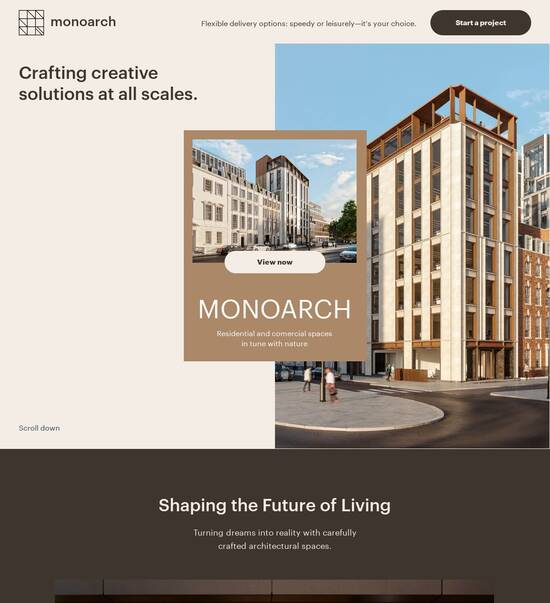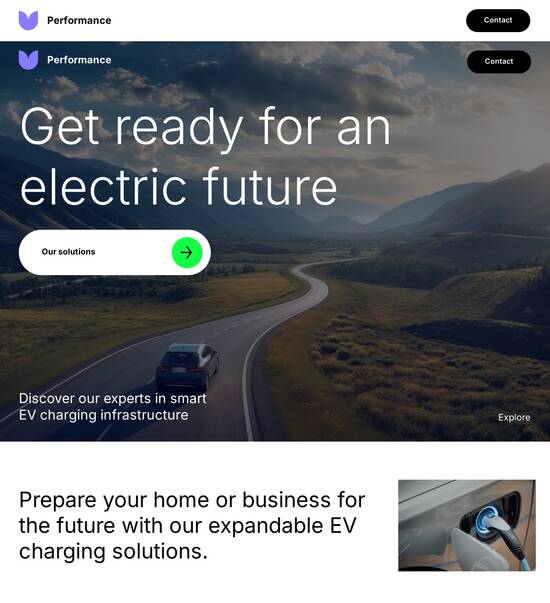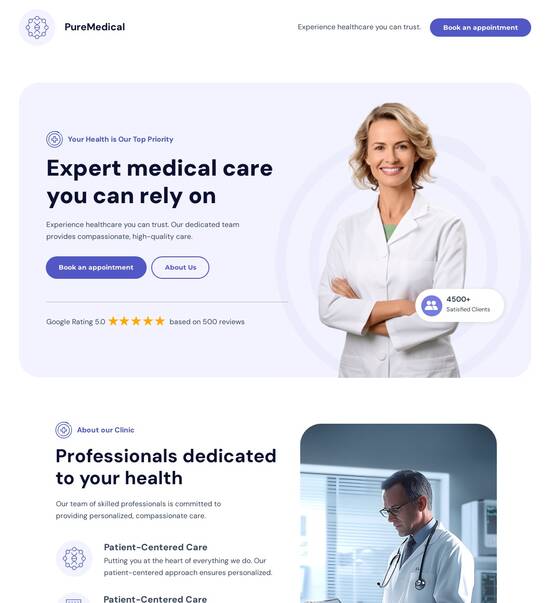
Landing page templates with pricing tiers
Explore Similar TemplatesAbout template
Manage your templates with pricing tiers and improve your conversion rates. Easily facilitate trust and transparency with your customers right now.
Recommended templates

Easy to build without coding
With the intuitive drag-and-drop builder, anyone on your team can create high-converting pages without any knowledge of code or design. Make enhancements to your landing page with custom widgets using Javascript, HTML/CSS, or third-party scripts.

Multiple layouts for any industry and goal
Select from 500+ landing page layouts built to boost conversions across industry-specific scenarios. Customize them by adjusting fonts, adding images, and generating on-brand content with the AI assistant. Quickly scale with Instablocks® and Global Blocks that you can save, reuse, and update globally.

Loads fast and looks polished on any device
Every template is responsive, which means they present professionally on any device and load blazingly fast with our Thor Render Engine. You can also power them up with Google AMP technology to deliver an unparalleled mobile experience and drive higher conversions.

Robust analytics & experimentation
Get real-time updates and reporting across all your devices, showing the number of visitors, conversions, cost-per-visitor, and cost-per-lead. Launch AI-powered experiments, run A/B tests, and use heatmaps to analyze user behavior, then optimize your landing page to maximize conversions.







Easy to build without coding
With the intuitive drag-and-drop builder, anyone on your team can create high-converting pages without any knowledge of code or design. Make enhancements to your landing page with custom widgets using Javascript, HTML/CSS, or third-party scripts.
Multiple layouts for any industry and goal
Select from 500+ landing page layouts built to boost conversions across industry-specific scenarios. Customize them by adjusting fonts, adding images, and generating on-brand content with the AI assistant. Quickly scale with Instablocks® and Global Blocks that you can save, reuse, and update globally.
Loads fast and looks polished on any device
Every template is responsive, which means they present professionally on any device and load blazingly fast with our Thor Render Engine.
Robust analytics & experimentation
Get real-time updates and reporting across all your devices, showing the number of visitors, conversions, cost-per-visitor, and cost-per-lead. Launch AI-powered experiments, run A/B tests, and use heatmaps to analyze user behavior, then optimize your landing page to maximize conversions.
All the features you need to build tier pricing template
Explore more featuresLearn how to build tiered pricing model template
Frequently asked questions about landing page design prices
Leading the way in building high-performing landing pages





Landing page setup rates: Your ultimate how-to guide
Instapage offers a comprehensive range of landing page templates and pricing tiers that can significantly enhance your digital marketing efforts. With access to over 100 high-converting templates, marketers across various industries can create effective campaigns tailored to their unique audiences. This guide outlines the steps necessary to utilize Instapage's resources effectively while ensuring a quick return on investment.
Understanding instapage landing page templates
Instapage's landing page templates are expertly crafted to maximize conversion rates for diverse marketing goals. Whether you're in tech, education, or financial services, the flexible designs cater to different verticals. By choosing a template that aligns with your campaign objectives, you'll be well on your way to generating leads and driving sales.
- High-converting design: Each template is optimized for conversions, ensuring your marketing messages resonate with your target audience.
- Customization options: Utilize intuitive builders to make essential tweaks without any coding skills required, tailoring your pages to reflect your brand.
- Lead generation elements: Access pre-built forms and tools designed to capture leads seamlessly, enhancing user experience and boosting overall engagement.
Selecting the right pricing tier
Choosing the right pricing tier is crucial for maximizing value and enabling your marketing team to access necessary features. Instapage offers a range of pricing options tailored to businesses of all sizes. Here’s a breakdown of how to select the right one.
- Evaluate team size: Understand your team's needs, especially if collaboration features are essential to your workflow.
- Determine feature necessity: Assess which features are critical for your campaigns, such as A/B testing or analytics dashboard.
- Budget considerations: Match your selected tier with your budget to ensure sustainable marketing practices that align with your financial plan.
Implementing your chosen templates effectively
After selecting a template and pricing tier, the next step is to implement your chosen landing pages effectively. This process involves understanding how to optimize your pages for different audiences and goals.
- Leverage personalization: Make use of tools like dynamic text replacement to deliver customized experiences for diverse segments of your audience.
- Utilize A/B testing: Experiment with different versions of your landing pages to identify what resonates best with your audience, refining your approach continuously.
- Integrate analytics: Monitor performance using detailed analytics to gather crucial insights that inform future campaigns.
By following these steps, you'll not only maximize your marketing impact but will also streamline your operations using Instapage’s powerful platform.
Don’t underestimate the potential that well-structured landing page templates bring to your campaigns. Start today and see how customizable Designs and strategic pricing can elevate your marketing game.
Ready to boost your ROI? Sign up for Instapage today and explore the powerful combination of templates and tiered pricing designed for marketers like you.
People also ask about real time fares in landing pages
The evolution of landing pages: harnessing pricing tiers for maximum impact
Understanding the role of pricing tiers in landing pages
Pricing tiers are structured representations of different pricing options available to users, typically displayed in a comparison format. They serve as an effective way to present multiple levels of service or product offerings, allowing customers to understand and evaluate their choices clearly. An effective pricing tier layout should be visually engaging and intuitive, ensuring that users can quickly identify the tier that best suits their needs. This visual representation helps in attracting users and guiding them toward making a purchasing decision.
The psychology of pricing tiers plays a crucial role in influencing consumer behavior. Customers often perceive greater value when options are presented as tiers, as it provides them with flexibility and choice. Behavioral psychology suggests that presenting multiple options can lead to increased sales, as customers feel more empowered in their decision-making process. When combined with effective visual designs, pricing tiers can create a sense of urgency and add value to the perceived offerings, further enhancing conversion rates.
The art of selection: choosing the right pricing tier model
Choosing the right pricing tier model starts with evaluating the target audience's needs. Understanding buyer personas and their preferences is crucial. For example, some users may prefer a basic package that provides essential features, while others might seek comprehensive offerings. Segmenting audiences allows marketers to tailor pricing strategies effectively, ensuring their offerings align with customer expectations.
There are several comparative models that are commonly utilized by SaaS companies, including Freemium, Tiered Pricing, and Per-User Pricing. Each of these models has its pros and cons. Freemium allows users to try a basic version for free before upgrading, which can attract a wider audience but may not always convert into paying customers. Tiered Pricing, on the other hand, offers different feature sets at varying price points, which can maximize revenue but may overwhelm some customers. Per-User Pricing scales costs based on user counts, ideal for larger organizations, but may deter smaller businesses with budget constraints.
Crafting compelling pricing pages: essential elements
Design fundamentals are crucial for creating effective pricing pages. A well-organized layout enhances user engagement, encourages exploration, and ultimately drives conversions. Key design principles include appropriate use of whitespace to avoid clutter, a compelling color scheme that captures attention, and typography that ensures easy readability. Clear distinctions between pricing tiers through strategic layout choices can make navigating options simpler for users.
Highlighting features and benefits is a pivotal part of the pricing page. Each tier should effectively showcase its features while translating technical specifications into customer-friendly benefits. For instance, instead of stating, '100GB of storage,' it’s more appealing to convey the idea that 'Easily store entire projects without worrying about space.' Techniques such as bullet points, icons, and brief descriptions can significantly improve user comprehension and engagement with tier offerings.
Innovative features in pricing page templates
Dynamic pricing tables have become a staple in modern pricing pages due to their ability to adapt to various devices. A responsive design ensures that users get an optimal experience whether they’re browsing on a desktop, tablet, or mobile device. Additionally, implementing hover effects and animations can guide user attention and highlight specific features or discounts, enhancing the usability of the pricing page.
Customizable designs are essential for aligning pricing pages with overall branding. A consistent visual language reinforces brand identity and builds trust with customers. For example, templates available from platforms like Instapage allow users to modify colors, fonts, and designs according to brand guidelines. Such customization can have a significant impact on users' perception of the brand and ultimately influence their buying decisions.
Pricing strategy: aligning with business goals
Setting the right price requires careful consideration of multiple factors. Market research and competitive analysis are vital in understanding where your offerings stand in relation to others. Price anchoring plays a significant role in consumer behavior; for instance, presenting a high-priced tier can make mid-range options appear more attractive even if they are still premium services. Knowing how to implement these strategies can greatly influence conversion rates.
Iterative pricing strategies are essential for long-term success. Testing and updating pricing models based on performance metrics should be a regular part of your workflow. A/B testing approaches allow companies to experiment with different pricing tiers, layouts, and messaging to determine which resonates best with their target audience. Utilizing tools specifically designed for A/B testing can provide valuable insights into customer preferences and behavior, leading to more informed pricing decisions.
Driving conversions through A/B testing and analytics
A/B testing is vital for optimizing pricing pages. Organizations can implement strategies that focus on testing specific elements, such as tier names, pricing, or visual design. By modifying one variable at a time, marketers can effectively gauge the impact on conversion rates. Relevant metrics to track include conversion rates, exit rates, and user engagement to identify areas needing improvement.
Utilizing analytics tools allows businesses to drive continuous improvement. Interpreting data from pricing page performance helps identify user behavior patterns. For instance, if users frequently drop off after viewing pricing, it may indicate that adjustments are needed to address potential objections. Case studies of SaaS companies that have successfully optimized pricing through analytics reveal the considerable impact data-driven strategies can have on enhancing growth and profitability.
Gaining inspiration: successful examples of tiered pricing pages
Studying real-world case studies of successful pricing page designs can provide valuable insights. Leading SaaS companies often employ creative strategies to engage and convert visitors. They showcase pricing tiers in ways that communicate value clearly and are appealing from a visual perspective. Observing how these companies structure their pricing pages can inform best practices for creating your own.
Creative modalities in presentation, such as comparison charts and customer testimonials, can also enhance the effectiveness of pricing tiers. Balancing aesthetics and functionality is essential; your pricing page should not only look appealing but also facilitate an easy decision-making process for potential customers. By analyzing various approaches, marketers can glean lessons that positively impact their tiered pricing designs.
The future of pricing pages: trends and innovations
Emerging trends in pricing strategies reflect the changing needs of businesses and consumers alike. Subscription models have gained popularity, with a shift towards usage-based pricing gaining traction. This trend allows customers to pay based on their usage, providing flexibility and potential cost savings that appeal to modern consumers. Additionally, the rise of artificial intelligence is paving the way for more personalized pricing experiences, tailoring offers based on user behavior and preferences.
Technological advancements in design, such as Progressive Web Apps (PWAs), promise to redefine pricing pages' capabilities. PWAs can enhance user experiences through fast loading times and offline browsing, making them an attractive option for companies looking to improve engagement. As new tools and platforms continue to emerge, businesses must stay abreast of these advancements to leverage them effectively in pricing page creation.
Final thoughts on leveraging pricing tiers effectively
Integrating user feedback into pricing strategies provides essential insights that can drive improvements. Mechanisms such as surveys or customer interviews can gather valuable customer insights post-purchase. These insights can then guide businesses in adapting their pricing models to better align with customer expectations and enhance satisfaction rates.
Creating a seamless user experience is paramount when designing pricing pages. The interplay between pricing pages and overall site navigation can significantly impact conversion rates. Strategies for ensuring fluidity between discovery and purchase include consistent visual design, clear calls to action, and intuitive navigation pathways. By prioritizing user experience, businesses can foster a positive relationship with potential customers, ultimately leading to higher conversion rates.
Ready to skyrocket conversions?
Supercharge your ad campaigns with high-performing landing pages
Get started














